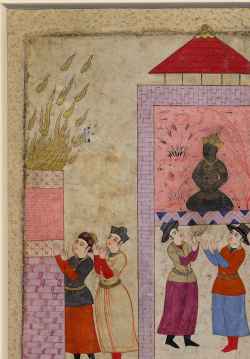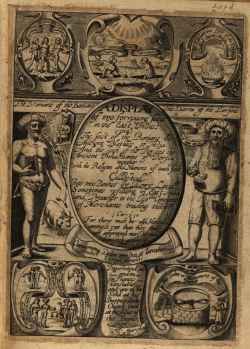Keyword: Persia – Image Gallery
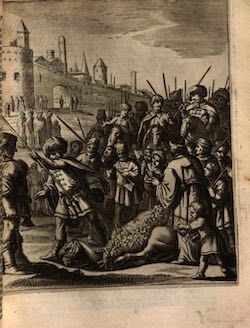
Sacrifice of the Camel (1666)
from: Della Valle, Pietro, De volkome beschryving der voortreffelijke reizen van de deurluchtige reisiger Pietro della Valle, edelman van Romen, in veel voorname gewesten des werrelts, sedert het jaer 1615, tot in 't jaar 1626 gedaan. Amsterdam, Abraham Wolfgang, 1666, vol. 1, pag. 128
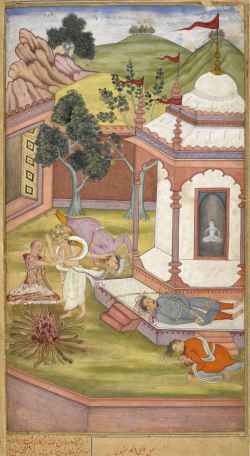
Candrahasa sacrifices himself cutting off pieces of his own flesh and putting them on the fire [1598]
from: Razmnāmah by Abhinanda, India (The last volume of the Persian translation of the Mahābhārata commissioned in 990 by Akbar)
London, British Library, Or 12076 folio: 90v
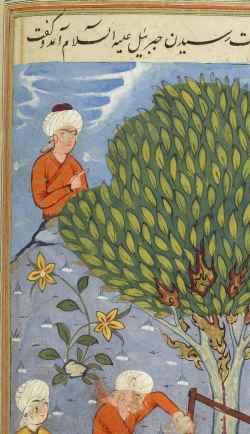
Martyrdom of Zakariya (XVI)
from: ishâq nishâbûrî, qisas-i qur'ân. [Qazvin, Iran]
Paris, BnF, Persan 54, fol. 144v

Zacharias sawn in half in a tree (1570-1580)
from: Qazwin, Iran
Dallas Museum of Art (Keir Collection), Dallas K.1.2014.1166 (III.278) folio: 231r
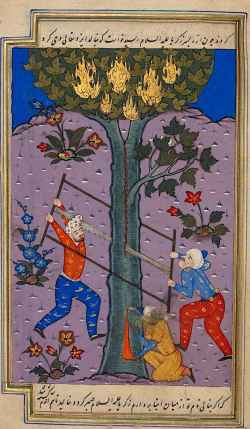
Martyrdom of the prophet Zakarīyā (Zechariah) (XVI)
from: Nīšāpūrī, Isḥāq Ibn-Ibrāhīm: Qiṣaṣ al-anbiyāʾ
Staatsbibliothek zu Berlin, Diez A fol. 3
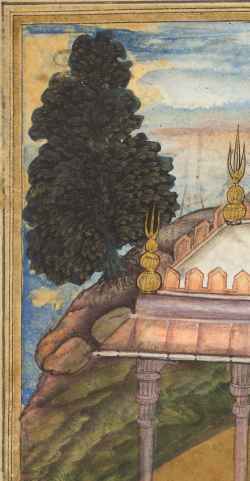
Yaja and Upayaja perform a sacrifice for the emergence of Dhrishtadyumna from the fire (1598)
from: from Adi-parva (volume one) of the Razm-nama (Book of Wars) adapted and translated into Persian by Mir Ghiyath al-Din Ali Qazvini, known as Naqib Khan (Persian, d. 1614) from the Sanskrit Mahabharata
The Cleveland Museum of Art
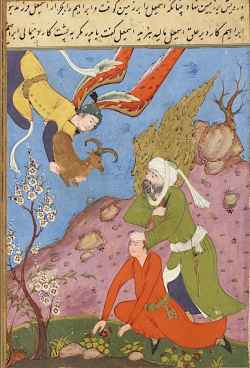
Abraham's Sacrifice (1595)
from: Histoire du Coran ou Histoire des prophètes et des rois passés. Qisas al-anbiyyâ [Supplément Persan 1313, fol. 40]
Bibliothèque nationale de France, Paris
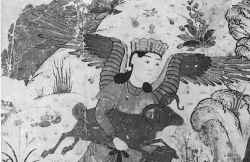
The Sacrifice of Isaac (1430)
from: Ms Hazine 2153, fol. 119
Istanbul, Topkapi Palace Museum, Hazine 2153, fol. 119
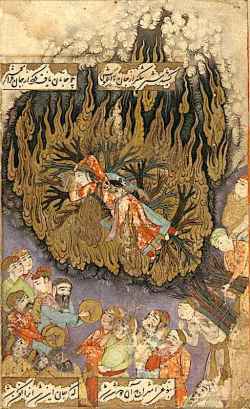
Satī. The bride immolates herself on the funeral pyre (1657)
from: Isfahan, Iran
The Israel Museum, Jerusalem
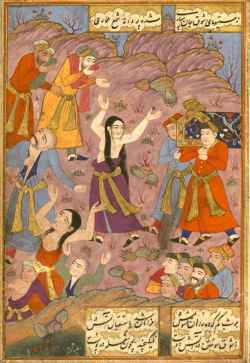
the young Hindu woman accompanies her bridegroom's coffin to the funeral pyre and decides to commit sati (1657)
from: Walters manuscript W.649 (Burning and Melting)
The Walters Art Museum

The Martyrdom of Zakarîyâ (Zacharias), the father of John the Baptist, who is killed when the tree in which he is hiding is sawn in two (c. 1580)
from: Nīsābūrī, Abū Isḥāq Ibrāhīm ibn Manṣūr, Qisas al-Anbiyâ [Qazvin?]
The New York Public Library, Spencer Coll. Persian MS. 46, fol. 144
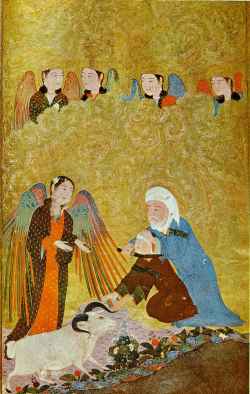
The Sacrifice of Isaac (Persia, Shiraz, Timurid period) (1410-1411)
from: Miniature from the Anthology of Sultan Iskandar (Persia, Shiraz)
Gulbenkian Museum, Lisbon
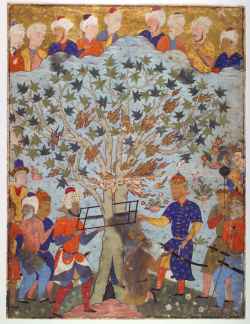
The story of the prophet Zakariya (a conflation of Zacharias, the father of John the Baptist, and the Old Testament prophet Zachariah), who according to Muslim legend died a martyr's death. Escaping his pursuers by hiding in a tree that miraculously opened to admit him, Zakariya was betrayed by Iblis, the devil, who pointed out the hem of the prophet's cloak protruding from the trunk. The devil's forces sawed the tree apart and with it Zakariya, whose saintly aura is shown as flames bursting among the leaves. (1550-1560)
from: from a dispersed copy of the Falnama (Book of Omens)
Worcester Art Museum
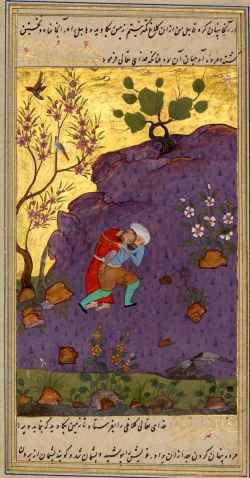
Qābil (Cain) and the dead Hābil (Abel) (XVI)
from: Nīšāpūrī, Isḥāq Ibn-Ibrāhīm: Qiṣaṣ al-anbiyāʾ
Staatsbibliothek zu Berlin, Diez A fol. 3

The Sacrifice of Isaac (16th)
from: Qiṣaṣ al-anbiyāʾ, Nīšāpūrī, Isḥāq Ibn-Ibrāhīm
Staatsbibliothek zu Berlin, Diez A fol. 3
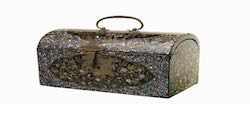
Reliquary of Safavid Influence (16/17 century)
São Roque, Lisbon
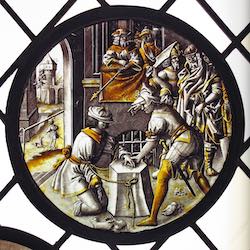
Roundel with Martyrdom of Saint Jacobus Intercisus [1520]
The Met Cloisters, New York
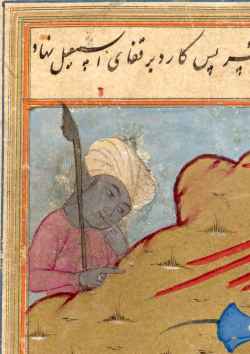
Ibrâhîm [Abraham] holding a knife is about to sacrifice his son Ismâ'îl (Ishmael) who kneels before him (1580)
from: Qisas al-Anbiyâ [Qazvin?]
The New York Public Library, Spencer Coll. Persian MS. 46
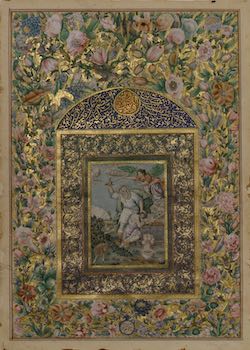
Abraham's Sacrifice (XVII)
Metropolitan Museum, New York
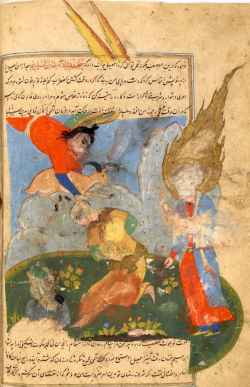
Abraham's Sacrifice (1600?-1650?)
from: Mîr Hwând, Rawzat al-safâ (Le lieu de repos des Purs) [Suppl. Persan 1567, fol. 50v]
BNF
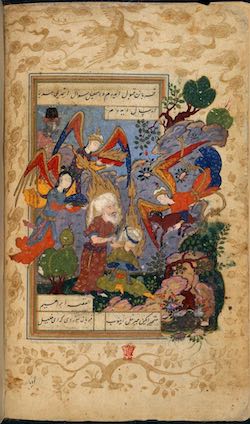
Ibrahim about to sacrifice Ismail. Cebrail (Gabriel) stands nearby holding the ram. (Late 16th/Early 17th)
from: A miniature painting from a manuscript of Hadikat us-suada, a history of the holy martyrs of the Prophet's family [Ms Or. 12009, fol.19v]
British Library, London [from Turkey]

The Sacrifice of Isaac [1581]
from: Ishâq al-Nishâpûrî, Histoire du Coran ou Histoires des prophètes et des rois du passé. Qesas al-anbiyâ [Persan 54, fol. 32v]
Paris, BnF, ms Persan 54 fol. 32v
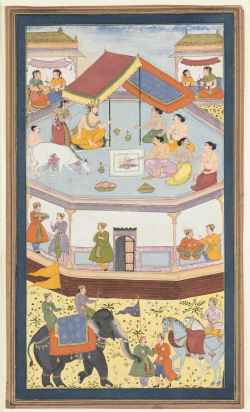
The sacrifice of the horse (asvamedha) by King Yudhisthira [1598 - 1605]
from: Ramznama
Louvre, Paris
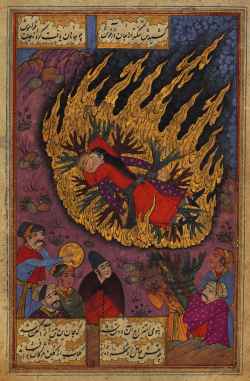
Satī, from a Sūz u Gudāz manuscript. The union of the couple on the pyre (1657)
from: Sūz u Gudāz ms, Iran, Walters Manuscript W. 649, fol. 19b (Burning and Melting)
The Walters Art Museum, Baltimore, Maryland

